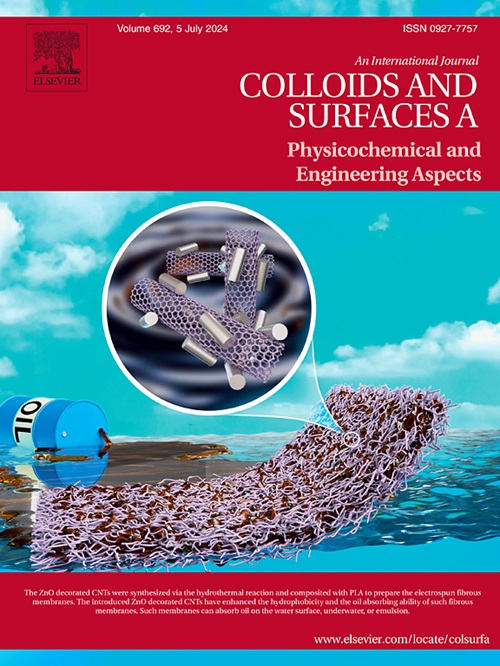Enhancement of corrosion, biocompatibility and drug delivery properties of nitinol implants surface by Al-Zn-LDH nanohybrids
IF 4.9
2区 化学
Q2 CHEMISTRY, PHYSICAL
Colloids and Surfaces A: Physicochemical and Engineering Aspects
Pub Date : 2024-10-09
DOI:10.1016/j.colsurfa.2024.135524
引用次数: 0
Abstract
This study investigates the enhancement of drug delivery and corrosion resistance by incorporating dexamethasone sodium phosphate into aluminum-zinc layered double hydroxide (LDH) coated nickel-titanium alloys. The nickel-titanium samples were fabricated from titanium and nickel powders using spark plasma sintering (SPS) and cold press sintering (CPS), followed by electrophoretic deposition of LDH nanoparticles. This composite construction aims to utilize the biocompatibility and mechanical properties of nickel-titanium, combined with the controlled drug release and corrosion resistance properties of LDH coatings. Structural and microstructural characterizations were performed using X-ray diffraction and scanning electron microscopy. The results indicated that SPS samples exhibited superior microstructural homogeneity and corrosion resistance compared to CPS samples. Dexamethasone sodium phosphate was successfully intercalated into the LDH layers, as evidenced by an increase in layer spacing from 7.14 Å to 20.130 Å. The LDH-coated nickel-titanium with intercalated dexamethasone sodium phosphate demonstrated a 5 % lower drug release rate and significantly improved corrosion resistance compared to uncoated samples. Cell adhesion studies confirmed good biocompatibility between cells and the coated surface. This composite material shows promise for enhanced performance in biomedical applications, particularly in drug delivery and corrosion resistance.
Al-Zn-LDH 纳米杂化物增强镍钛诺植入物表面的腐蚀性、生物相容性和给药性能
本研究探讨了通过在铝锌层状双氢氧化物(LDH)涂层镍钛合金中加入地塞米松磷酸钠来增强药物输送和耐腐蚀性能的问题。镍钛样品由钛粉和镍粉通过火花等离子烧结(SPS)和冷压烧结(CPS)制成,然后电泳沉积 LDH 纳米粒子。这种复合材料结构旨在利用镍钛的生物相容性和机械性能,结合 LDH 涂层的药物控释和耐腐蚀性能。利用 X 射线衍射和扫描电子显微镜对结构和微观结构进行了表征。结果表明,与 CPS 样品相比,SPS 样品具有更好的微观结构均匀性和耐腐蚀性。地塞米松磷酸钠成功地插层到 LDH 层中,层间距从 7.14 Å 增加到 20.130 Å 就是证明。与未涂层的样品相比,夹层地塞米松磷酸钠的 LDH 涂层镍钛的药物释放率降低了 5%,耐腐蚀性也显著提高。细胞粘附研究证实,细胞与涂层表面之间具有良好的生物相容性。这种复合材料有望提高生物医学应用的性能,特别是在药物输送和耐腐蚀方面。
本文章由计算机程序翻译,如有差异,请以英文原文为准。
求助全文
约1分钟内获得全文
求助全文
来源期刊
CiteScore
8.70
自引率
9.60%
发文量
2421
审稿时长
56 days
期刊介绍:
Colloids and Surfaces A: Physicochemical and Engineering Aspects is an international journal devoted to the science underlying applications of colloids and interfacial phenomena.
The journal aims at publishing high quality research papers featuring new materials or new insights into the role of colloid and interface science in (for example) food, energy, minerals processing, pharmaceuticals or the environment.

 求助内容:
求助内容: 应助结果提醒方式:
应助结果提醒方式:


